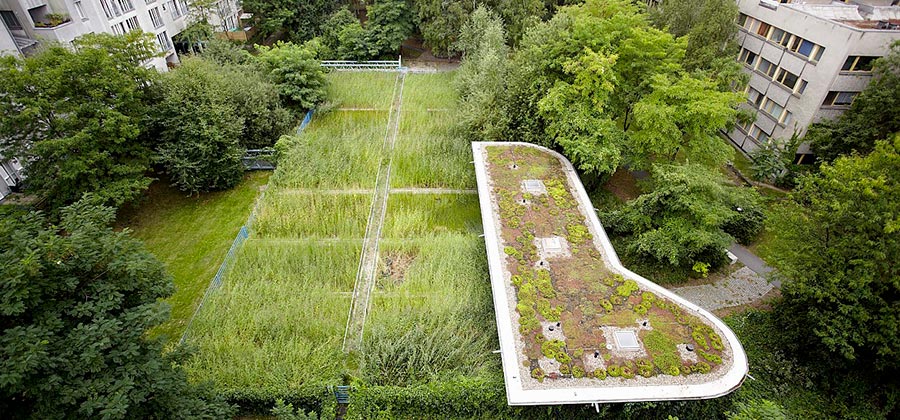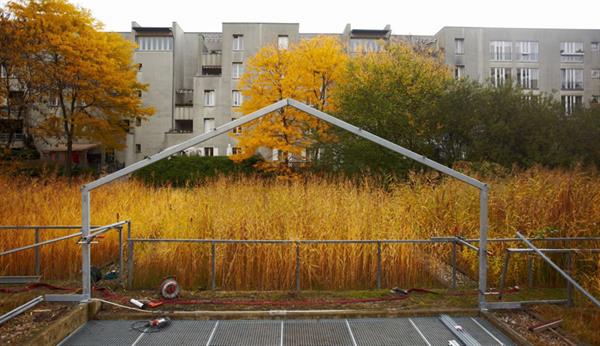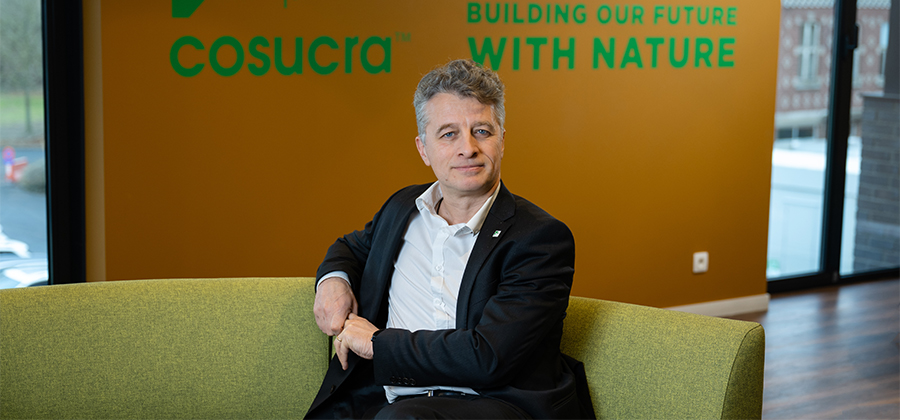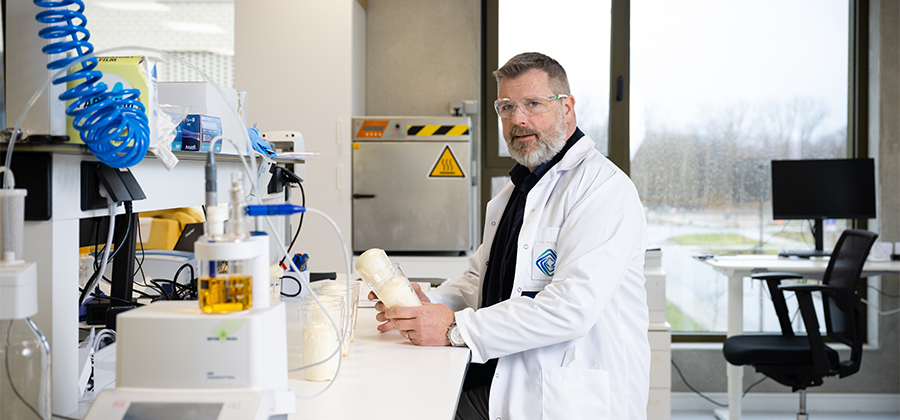Yet while easy to say, the practice is still not a matter of course. Because our blue planet is not as blue as it seems, and recycling waste water is an ethical way of treating a resource that is scarcer than we realise. We went to Block 6 in Berlin's Kreuzberg district to find out more.

The challenge
Did you know that fresh water accounts for less than 4% of the planet's water resources, and that most of this is unusable, buried deep below ground or packed away as ice? Contrary to appearances, fresh water is not a boundless resource that simply needs to be directed through our taps. Whether intended for domestic or industrial purposes, water must be collected, treated, distributed and decontaminated after use. It generates a considerable financial cost, and its price will continue to rise into the future.
Armed with these facts, a pilot project is under way in the Kreuzberg district of Berlin at the heart of a complex of buildings called "Block 6", as well as on some neighbouring sites. It is here that 30 years ago, a waste water treatment plant was created and has continued to be perfected over the years. The system functions effectively and supplies water that is clean and less expensive than mains water. It is making people think, which is precisely the objective.
A model to emulate
Block 6 contains around 180 flats housed in a quadrangle of properties positioned around a green space that combines areas for recreation and water treatment. Strong environmental concerns were part of the original concept for the block, which was built in 1987. One of these is the treatment of waste water known as "grey water" (water from baths, showers, sinks and washing machines, which is not heavily contaminated). This is why the block was constructed to include a dual network of pipes, enabling water to be collected according to its source and then reused in different ways.

They say practice makes perfect, and this also applies to water systems: over time, the facility has been significantly improved. The technology is now mature, and the results obtained are more than convincing. In short, “grey water” is directed into a series of tanks where it undergoes a gradual biological treatment process involving the addition of selected bacteria. At the end of its journey, the water is restored to a quality close to that of mains water, and can be reused without the slightest risk. Since current legislation does not allow treated water to be regarded as drinking water, it is only used to supply toilets and gardens. However, this is a legal restriction that has no relation to the water's inherent quality, and the law could be amended to allow reasonable use of this new resource.
Waste water or a raw material?
Over time, the experiment was widened to include so-called "black water" – the dirtiest water flowing from kitchens and toilets. This water, which is full of nutrients and different chemical compounds, is collected via a separate network of pipes and must be treated in a specific manner. Treating “black water” locally is advantageous for two reasons: Firstly, it allows pollutants to be captured "at source" and much more effectively than when they are diluted in the large quantities of water that make their way to more remote treatment plants. With this system, harmful compounds are prevented from being released into the oceans, where they can no longer be removed. Secondly, nutrients such as nitrogen and potassium present in waste water can be salvaged and reconverted into fertilisers which are no different to those sold on a commercial basis. Considering that more than one litre of oil is used for the industrial production of one kilogram of fertiliser, it is not difficult to see how beneficial it would be to envisage waste water as a new raw material. However, this is experimental research yet to evolve into a commercially available product. But it certainly works!
Source of energy
Reusing water collected nearby offers further benefits still, not least the robustness of the process: this is tightly controlled, and the risk of service interruptions is very low. Should problems arise, a temporary service interruption can be resolved by simply switching to the public mains supply. And since the price of reused water is lower than that of mains water, this becomes a supplement to locally-produced water and the cost to the final user can be reduced.
Another significant aspect of supplying water is the energy required. The urban water cycle uses a huge amount of electricity. For example, supplying water to Berlin and it 3.5 million inhabitants uses the same amount of electricity as the entire consumption of a town with 280,000 people. Recycling water in the same place allows energy to be saved. It is entirely possible to convert the residual heat from grey water (for the most part produced in bathrooms) to electricity, which is then in turn used to pre-heat the water directed to these same bathrooms. Proximity is the key to success since the greater the distance, the more heat is lost. And by maximising the energy recovered on site, the additional energy used to supply water can be minimised: a gain on two counts.
A technique of the future
This model works – the results are there to prove it. Since 2013, the site has also served to demonstrate the efficiency of local recycling techniques. Studies are under way here with a view to improving methods further still, and to take them in new directions. We have already touched on the production of liquid nutrients for agriculture, but we can add to this plant cultivation (hydroponics), fish farming (aquaponics) and the production of liquid fertiliser extracted from so-called "black water". Not to forget the original objective of the plant, which is to convert waste water into clean water that can be reintroduced into consumption channels. Drinking recycled water is certainly not yet on current menus, but the idea will gain ground because a time will quickly come when there will simply be no other alternative. Is this not already the case on space stations?
To find out more, go to: www.roofwaterfarm.com/en/block-6
16.05.2024
Kazidomi: a healthy online supermarket
A subscription to build customer loyalty, reinvent yourself in times of crisis and buy better: Emna Everard saw that as exactly the right way to launch and maintain her Brussels-based start-up.
Born into a family of dietitians, Emna Everard knows what it means to eat healthily. "At the age of 12, I was already deciphering packaging labels. My dream was to open a supermarket one day where you could shop with your eyes closed", she recalls.
And because Everard has entrepreneurship in her bones, that’s exactly what she did. In 2016, just before the end of her university studies, she launched the “healthiest online supermarket on the market”: Kazidomi. Her standards are high, both in terms of composition and taste. Kazidomi selects products carefully, enabling its customers to buy healthy, mainly organic, plant-based products with complete confidence.
The loyalty programme
Six months after its launch, Kazidomi’s growth is accelerating thanks to the launch of its loyalty programme. A 59 euro subscription offering 20–50% discounts on all food, cosmetics or care products available online. Profitability and savings guaranteed.
This was followed by a first fundraising of €50,000 in 2017. Kazidomi is growing, expanding the size of its stock and developing its marketing. Everard hired her first two employees. Sales grew rapidly and literally exploded during the COVID-19 pandemic. "Consumers suddenly had time to think about their health and well-being and were doing most of their shopping online," she adds.
How did you reinvent yourself?
The post-crisis period was a turning point. "Kazidomi had to reinvent itself. We wanted to have financial stability and avoid any dependence on external resources," continues Everard. Together with her teams, she looked at their cost structure, operational efficiency and marketing. After these reflections, the aim was no longer growth at any price, but the company's long-term viability and financial health, thanks to an intelligent reorganisation.
Two acquisitions would subsequently enable Kazidomi to boost its growth, creating significant synergies: "Smart Fooding" in August 2022 and "Bébé au Naturel" a few months later, a business specialising in healthy products for babies and their parents. "With Bébé au Naturel, we doubled the volume of orders sent out," adds Everard. "This has allowed us to get a better rate from our carriers and reduce costs."
A responsive and attentive bank
As the Brussels start-up’s bank, BNP Paribas Fortis granted it three loans for its launch, between 2016 and 2019. This support came naturally, with Kazidomi’s commitments in terms of Environmental, Social and Governance (ESG) objectives perfectly aligned with the bank’s strategy. "We joined the BNP Paribas Fortis Innovation Hub programme and our relationship manager – who knew the start-up environment extremely well – was immediately enthusiastic and very attentive. He believed in our project, followed it closely, advised us to participate in a series of events to meet other players whose background and profile would be of interest for us," explains the Entrepreneur of the Year 2019.
But the support didn't stop there. "In December 2022, it was thanks to BNP Paribas Fortis, among other things, that we were able to acquire “Bébé au Naturel”. Start-ups like Kazidomi need a high level of responsiveness from their bank. When there is a company to buy, or another opportunity, things have to move fast. Analysis of the file, provision of funds: BNP Paribas Fortis has always been responsive and enthusiastic and has supported us in 99% of our requests," says the CEO enthusiastically.
|
Eight years since launching, Kazidomi today has 4,000 products that it delivers across Europe. The Belgian start-up makes 90% of its sales on its website and 10% via external resellers, such as Delhaize. Kazidomi has also launched its own brand “Kazidomi”, which has 200 products on offer. By working directly with producers, we can offer the best possible quality products at the best price. |
Kazidomi is ready to change the world. Discover even more inspiring entrepreneurial stories.
14.05.2024
Less CO2 and healthier food
Cosucra is investing in the decarbonisation of its production processes. Their focus is on using fibre and plant-based protein from chicory and peas for a healthy and less polluting diet.

Belgium’s Hainaut-based Cosucra has been operating since 1852. The company is quite small with 365 employees, but its activities have evolved over time. From the 1980s onwards, sugar beet processing gave way to chicory and yellow peas. Also, sugar was replaced by inulin and pea protein.
"Many families lack the time to put a fresh meal on the table every day. With our products, the industry can offer them easy, quick and nutritious meals," says Eric Bosly, CEO of Cosucra. "Nutritionists stress the importance of fibre and plant proteins for health, and such a diet has a positive impact on our carbon footprint."
New investors
To take their decarbonisation a step further, in 2023, the company launched a seven-year investment plan worth EUR 150 million. “We are keenly aware of the climate crisis, so we wanted to make this transition fast,” says Bosly. “That's why we brought three investors on board who share our values and are willing to commit in the longer term.”
Long-term relationship
Cosucra and BNP Paribas Fortis have a long-standing partnership. "The bank has supported us in expanding to Denmark and the United States. It's of great value to have the same contact person for setting up the financial structure of subsidiaries, opening accounts abroad, etc. We also meet regularly, which means we can count on the expertise of teams specialised in the food industry. Their macro vision complements that of our local account managers who know our business well."
Same market conditions
Cosucra’s efforts will result in a 55% reduction in CO2 emissions within three years. Yet, decarbonisation is just one of Bosly’s bold ambitions. "We are pushing for the same market conditions as animal proteins. Why, for example, is 20 per cent VAT levied on pea-based milk while for cow’s milk, this figure is under 6 per cent? Plant-based products are also more expensive because you can't achieve economies of scale due to the lower quantities required. If you consider all the “negative external effects” of animal products on human health and the environment, our sector deserves support until we reach a certain scale."
Change of mindset
The entrepreneur also laments how the retail sector uses meat as a decoy product, lowering its margins to offer consumers an attractive price. "In times of inflation, that price difference is all the more detrimental to us. This is why a change of mindset is essential. Nutritionists say that a weekly serving of just 200 to 250 grammes of meat is enough to get the nutritional benefits with no negative impact. But at the moment, most Belgians consume 200 grammes of meat per day."
Bosly also cites competition from imported agricultural products as an obstacle.
Cosucra is ready to change the world. Discover even more inspiring entrepreneurial stories.
"The European Green Deal aims to reduce inputs by half, leading to the ban of many herbicides, among other things. Farmers should be supported in this transition. And a company like Cosucra, which buys chicory and peas within a 200-kilometre radius, is not on an equal footing with strong Chinese competition."
13.05.2024
Brepols prepares for the future
Since 1796, Brepols has been producing diaries that allow you to better plan your time. The team is fully committed to people, the planet and prosperity.
"From Turnhout to a branch in Paris, our 110 employees create tools that help our customers manage their time better. And that benefits their work-life balance," says Finance Director Philippe Pissens. "Quality, craftsmanship and creativity are at the heart of our products. Brepols’ diaries, calendars and notebooks are not disposable products - they easily last a year. We also make business leather goods under the Maverick brand and and we have launched a brand-new collection of high-quality notebooks under the brand name "de KEMPEN". In addition, we distribute the famous Moleskine notebooks. Finally, there are our bookbinding activities," he says. Brepols’ main markets are the Benelux and France.
Financially on track
Since starting out in 1796, Brepols has seen many trends and developments come and go. The last few years have been marked by growth. This is thanks to the Financial Director, who came on board in 2000. With turnover of EUR 17.4 million in 2021, EUR 19.6 million in 2022 and EUR 20.8 million last year, the company is clearly on the right financial track. "These figures are not just a result of price increases. We are a strong company with a solvency of 70 per cent, which means that we only finance 30 per cent with external funds," he explains.
More than planting trees
"Since 2009, we have only used Forest Stewardship Council (FSC)-labelled paper. For every tree cut down, a new one replaces it. But there's always room for improvement. In 2022, we launched a project group comprising staff across the company. We call it P3, because we focus on people, the planet and prosperity."
The project group analysed the company’s strengths and weaknesses, with the employers’ organisation Voka acting as a sounding board. “We certainly didn't want to make the mistake of greenwashing,” says Pissens. Specifically, Brepols developed 18 action points, which means it already covers nine of the 17 Sustainable Development Goals. In addition to a charter, there is a code of conduct that suppliers must sign and respect. Other initiatives include focusing on local production, limiting residual waste, reducing energy consumption and developing a HR policy that takes diversity and inclusion into account. “The aim of this project group is to create internal and external support and communicate clearly with all our stakeholders.”
Fluid organisation
"Honesty and transparency towards our employees are top priority," Pissens continues. "We have intensive consultations with them, both formal and informal. We deliberately opt for a fluid organisational model, between the hierarchy and the self-managing teams, and there has been a high level of participation. This is crucial as a quarter of our employees will be retiring in the next three years. In this context, we also purchased cobots, which makes the work less physically demanding for our staff."
Clear communication
Pissens emphasises the importance of clear communication to all stakeholders, including its financial partners, such as BNP Paribas Fortis. "The bank has become key to our business operations. We provide our relationship manager with detailed figures and keep her up to date with our sustainable ambitions. Our contacts at BNP Paribas Fortis not only provide us with information about financial products; they also give us tips, such as measuring our energy consumption and the possibilities for subsidies to install solar panels, for example. We have an effective two-way communication. Our collaboration has grown into a real partnership. In our business, paying attention to Environmental, Social, Governance (ESG) aspects is the benchmark in every consultation," Pissens concludes.
Quote
"The bank has become a key figure in our business operations”
Philippe Pissens, Finance Director Brepols
Brepols is ready to change the world. Discover even more great stories from entrepreneurs.
06.05.2024
Triple Helix disrupts the value chain
Triple Helix calls itself the world’s first vertically integrated processing company, offering the industry a completely reversed value chain. Starting with the chemical industry.

Triple Helix aims to create change in the traditional and capital-intensive chemical industry by investing in alternative commodities and recycling. "In a nutshell, we want to prevent products from being incinerated or landfilled at the end of their life by recovering the material streams and turning waste into new commodities," says CEO Steven Peleman. "And I really do mean any waste stream. Our first project is a factory to break down polyurethane foam and reuse it as a liquid raw material for industry."
Venture studio
Peleman and his three partners know the chemical industry inside out and are aware that it is very difficult to broker change. "Some of these plants have been around for decades. Simply saying that we intend to do things radically differently and disrupt the market? That is not how it works, which is why you need smaller companies that serve as a catalyst for change."
The core of Triple Helix is formed by an independent venture studio that sets up and develops circular projects, creating the right ecosystems around them. "We started with the industry we know best and are gradually expanding our business. We now have a dozen legal entities and are working on a new cluster, focusing on CO2 and sulphuric acid recovery."
Friends, family and fools
As a start-up, Triple Helix is still in the investment phase. “This is a huge challenge,” Peleman says. "These days, the only way to finance a venture like ours is to find investors who can afford to take risks, especially in an industry like ours, with expensive installations, test equipment and laboratories. But the profiles you need are also very expensive. Because you need the experience and knowledge. During the start-up phase, you basically have no choice but to rely on friends, family and other contacts. Our credibility is increasing in leaps and bounds, giving us more clout," says Peleman.
Scalable and cost-effective
The polyurethane recycling plant will be their first lighthouse project. "We want to show that our business model works and that it is scalable and profitable to get traditional equity players to invest."
They expect to finalise the financing in the first quarter, so they can start building the factory at the end of March. "We’re ready. The lab results are good. We have a commitment from market players to supply and purchase material. And we are in discussions with three countries to roll out the plant internationally."
Over the next two years, Peleman wants to make the infrastructure profitable and further expand the other ventures. "It’s not our intention to create one hundred companies. But we do want to set up a few that provide actual solutions to problems and then internationalise them. Between five and ten years, we want to be able to say that the entire set-up has been financed, is running smoothly, and delivering great results so that we can hand it down to the next generation."
Ready to push boundaries together
BNP Paribas Fortis has been following and advising Triple Helix for three years, from when they first presented the idea to the concrete development of the financing options. “We went through a learning process with the bank,” Peleman says. “You need to build a relationship and get to know each other, so both parties can assess the risk.”
Today, BNP Paribas Fortis is one of two banks in a consortium that will help finance a large part of the factory. "I see that the bank has the in-house knowledge to understand what we are doing. But understanding what we do is more important than knowledge. And that is something the bank definitely provides."
Triple Helix is ready to change the world. Discover more inspirational stories from entrepreneurs.
Quote
"We went through a learning process with the bank. You need to build a relationship and get to know each other so both parties can assess the risk," says Steven Peleman, CEO of Triple Helix.
